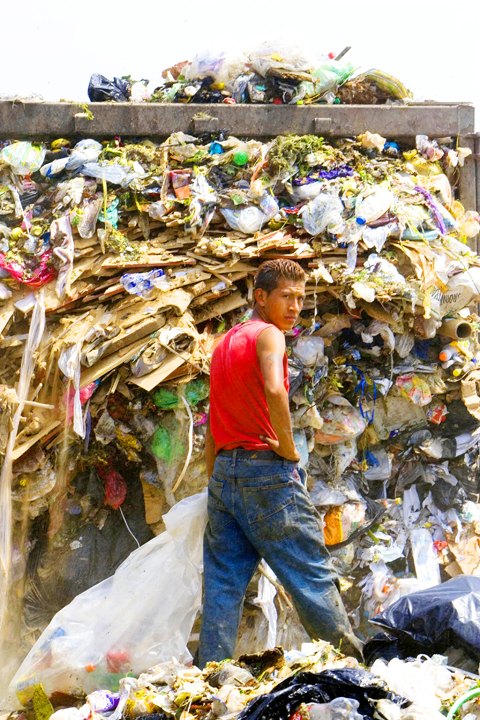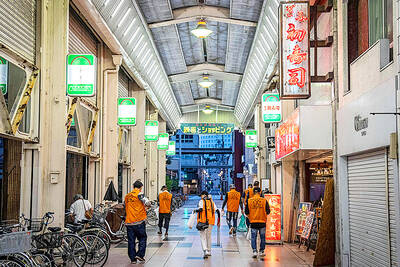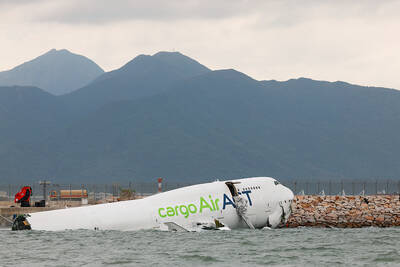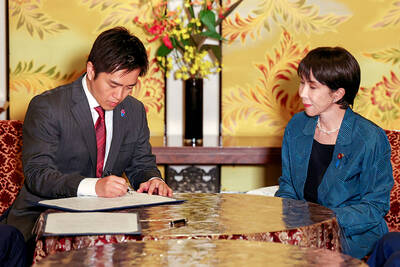Mexico City wants to turn one of the planet’s biggest and messiest waste management systems into the greenest in Latin America, if not the developing world.
A newly formed Waste Commission is working to build four state-of-the-art processing centers in the next four years to recycle, compost or burn for energy 85 percent of Mexico City’s trash — compared with about 6 percent recycled today. If it works, it would put this sprawling, polluted metropolis in a league with San Francisco, the Netherlands and other top recyclers, and first among developing cities, where the recycling rates mostly hover around 10 percent.
“The whole concept of recycling is very new in Latin America,” said Atiliano Savino, president of the International Solid Waste Association.

PHOTO: AP
While many places are good at recycling one thing, such as aluminum, Savino said he had never seen a city revamp its recycling program on this scale in so little time. US and European cities that now have recycling rates of more than 50 percent began decades ago.
NO CHOICE
But Mexico City has no choice. The federal government proposed to close the city’s main landfill this month, saying the 50 million-tonne dump has become too full and leaches contamination. Scientists dispute that and the closing has been delayed by a city appeal in federal court for an extension. Yet waste management officials know that soon much of Latin America’s largest metro area will be forced into expensive, temporary alternatives for dumping trash.
It will take more than technology to recycle most of the 12,500 tonnes of trash the mega-city produces daily. As in much of the developing world, Mexico City residents aren’t accustomed to separating their garbage.
But Fernando Menendez, the dapper, silver-haired Waste Commission director, says naysayers need only look at the success of his other major environmental project. No one thought he could get Mexico City residents out of their cars to cut air pollution, either. But his Hoy No Circula campaign now idles at least 1.6 million cars a week.
“Nobody has ever done anything like this,” Menendez said of shutting down what he calls the world’s biggest landfill. “But it has to work. There’s no other option.”
The Bordo Poniente dump was built on a dry lake bed on the northeast edge of the city in part to handle the rubble from the devastating 1985 earthquake. It now takes about 700 truckloads of unsorted rubbish a day.
SORTING TRASH
The city has required residents to sort trash since 2003, but without providing the infrastructure to handle it. Ninety percent of garbage trucks lack separate compartments for organic and inorganic waste. Thirteen transfer stations are supposed to process waste separately. But on a recent afternoon at a mid-sized center, three men were shoveling tree branches into a pit with plastic foam cups.
That’s where the enterprising informal economy takes over. Mexico City’s garbage workers union officially employs 17,000 and at least 8,000 more unofficially. Paid drivers and so-called volunteers make extra cash collecting “tips” from customers and selling aluminum and cardboard from their routes. Some union members rake in as much as three times their wage.
Meanwhile, just outside the Bordo Poniente, garbage pickers, including some children, sift through waste on fast-moving conveyer belts with their bare hands in a foul and dangerous open-air pit.
The Waste Commission plans to replace the ad-hoc system with new processing centers — about 180 million pesos (US$13 million) apiece — that by 2012 will recycle 20 percent of Mexico City’s garbage, compost 20 percent more and burn another 45 percent for energy.
As of November, only one center, in the rural southern delegation of Tlahuac, had been approved. Menendez says he is negotiating with private investors to finance the other three, while the Tlahuac center will be paid for with public funds.
The government also will harvest methane gas from the Bordo for energy to power the subway and light homes.

A missing fingertip offers a clue to Mako Nishimura’s criminal past as one of Japan’s few female yakuza, but after clawing her way out of the underworld, she now spends her days helping other retired gangsters reintegrate into society. The multibillion-dollar yakuza organized crime network has long ruled over Japan’s drug rings, illicit gambling dens and sex trade. In the past few years, the empire has started to crumble as members have dwindled and laws targeting mafia are tightened. An intensifying police crackdown has shrunk yakuza forces nationwide, with their numbers dipping below 20,000 last year for the first time since records

CAUSE UNKNOWN: Weather and runway conditions were suitable for flight operations at the time of the accident, and no distress signal was sent, authorities said A cargo aircraft skidded off the runway into the sea at Hong Kong International Airport early yesterday, killing two ground crew in a patrol car, in one of the worst accidents in the airport’s 27-year history. The incident occurred at about 3:50am, when the plane is suspected to have lost control upon landing, veering off the runway and crashing through a fence, the Airport Authority Hong Kong said. The jet hit a security patrol car on the perimeter road outside the runway zone, which then fell into the water, it said in a statement. The four crew members on the plane, which

Indonesia was to sign an agreement to repatriate two British nationals, including a grandmother languishing on death row for drug-related crimes, an Indonesian government source said yesterday. “The practical arrangement will be signed today. The transfer will be done immediately after the technical side of the transfer is agreed,” the source said, identifying Lindsay Sandiford and 35-year-old Shahab Shahabadi as the people being transferred. Sandiford, a grandmother, was sentenced to death on the island of Bali in 2013 after she was convicted of trafficking drugs. Customs officers found cocaine worth an estimated US$2.14 million hidden in a false bottom in Sandiford’s suitcase when

Japan’s ruling Liberal Democratic Party (LDP) and its junior partner yesterday signed a coalition deal, paving the way for Sanae Takaichi to become the nation’s first female prime minister. The 11th-hour agreement with the Japan Innovation Party (JIP) came just a day before the lower house was due to vote on Takaichi’s appointment as the fifth prime minister in as many years. If she wins, she will take office the same day. “I’m very much looking forward to working with you on efforts to make Japan’s economy stronger, and to reshape Japan as a country that can be responsible for future generations,”